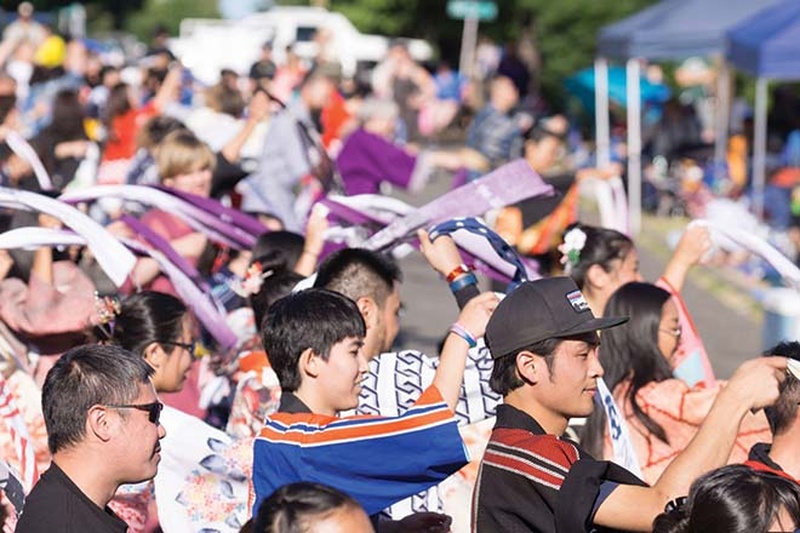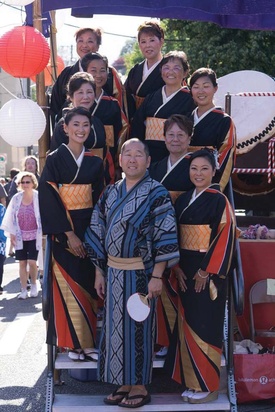As we rehearse our Bon Odori dance moves and get ready to be part of the festival this July 21, let’s take a moment to honor those who put this Seattle tradition in motion. This will be our 86th Bon Odori as far as the records go, and it will be hosted by Seattle Betsuin, which was founded in 1901. Those are some deep Seattle roots.
According to the book Mukashi Mukashi by Ronald E. Magden, the first Seattle Bon Odori was held in 1932. Reverend Yoshi Iwanaga was introducing traditional folk dances to Japanese communities on the West Coast. A tofu manufacturer sponsored the reverend’s trip to Seattle, where he taught the Bon Odori dance moves to Fukoku Nakatani, a Japanese classical dance teacher. “In turn, she taught Corky Kawasaki and his wife, Yuri, along with Masaru Harada, Hatsumi Tachiyama, Yudai Arakawa, and Ayako Shinoda. Without much advance notice, those six dancers organized the first Seattle Bon Odori in front of the church on August 15, 1932.”
Magden writes that the “Bon Odori was an overnight success. The daily newspaper features and photos of the colorful ceremony ensured a large crowd for the next year.” And so the annual tradition had begun.
The North American Post talked with Seattle Betsuin Rev. Katsuya Kusunoki and temple board member (and Bon Odori Chair) Ron Hamakawa about the history of Seattle’s Bon Odori, the temple itself and its brand of Buddhism, Jodo Shinshu. Reverend Kusunoki is relatively new to Seattle, having arrived in April 2017, but he spent several years at a Buddhist temple in Lodi, California, after moving to the US from Nagasaki in 2010. Excerpts of the conversation follow.
* * * * *

Please tell us a little bit about the history of Seattle’s Obon festival.
Ron Hamakawa (Ron): This is our 86th Obon. We refer to it as the reported 86th because that’s as far back as we can confirm in terms of archived information. In some years because of the Vietnam War and World War II, there are some iffy questions as to whether it occurred or not. During some high racial tension points, the city asked us to suspend it here, and it was moved to the Seattle Center where I think the police thought they could be more protective. That was during the 1970s.
It was our forefathers who had the idea of really trying to be inclusive and fitting in to Seattle culture. We are one of the longest, community-sanctioned events at Seafair.
Rev. Kusunoki (Rev): One of the differences between Seattle’s Bon Odori and the California ones is that Seattle focuses on the Bon Odori. The main entertainment is the Bon Odori. In California, the food bazaar is the main activity. But here, the Bon Odori is the main event. In Lodi’s case, the Bon bazaar is two days, but the Bon Odori is only Sunday night, 7pm to 9pm. But here, the Bon Odori is on Saturday and Sunday – both days – from the beginning to the end. Five hours of dancing each day. Seattle really focuses on dancing!
Ron: We have a lot of dances.
Rev: I feel this is a more traditional style. Sometimes, I feel that Japanese Americans are keeping traditions alive more than the people in Japan. In Japan, only a few temples do Bon Odori. Japanese people should learn from the Japanese Americans.
Has the purpose of the Bon Odori changed over the decades?
Ron: For us it is really about remembering and being grateful toward those who have passed away, whether they were directly related to you or had an impact on your life somehow. Regardless of your ethnicity or faith, we all have people who are no longer here to whom we are grateful. That is why we celebrate Bon Odori in Seattle.
How did Seattle Betsuin come to be?
Rev: In the United States, the first temple was started officially in San Francisco in 1899. Two ministers came from Japan, and after that, in some cities like Sacramento, Seattle, Fresno, there were Japanese communities that built temples. (Betsuin was formed in 1901). It’s one of the oldest temples in the United States. This is the third building. The first one was in the International District. At first, they were just using somebody’s house, renting the place. They would get together on Sunday or some other weekday. As the congregation gradually got bigger and bigger, they built a temple. In 1941, they built this building, just before World War II. When the Japanese Americans were sent to the camps, the US Navy used this facility.
After the war was over, and the Japanese Americans came back to Seattle, they re-opened the temple.
Seattle Betsuin is an associate temple of Honganji in Kyoto. The school of Buddhism is Jodo Shinshu. In English, we call it True Pure Land Buddhism. Japan is a Buddhist country, and there are so many different schools. But Jodo Shinshu is one of the biggest religious organizations. A lot of people emigrated to Hawaii first, then came to mainland United States. While most Americans were going to church on Sundays, the Japanese had no place to go, so that was one reason to build a temple. Then, for the younger people’s education – because there was no place to learn Japanese culture or traditions and Buddhism – the temples were built so everyone could gather on the weekend or even the weekdays. One aspect of this temple is to be a social place for Japanese people. It’s a little different from the temples in Japan.
Ron: Sensei, would you say that as the Nisei were being born, many of the Issei parents wanted them to have an understanding of the language? And that’s why a lot of temples had a Nihongo Gakkoo (Japanese language school)?
Rev: Yes. Before I came to Seattle, I was at Lodi Buddhist Temple. In Lodi’s case, they built the language school first, then they built the temple. You can say that one of the purposes of a temple is to have a language school.
Ron: I also think that some of the racial tensions in the postwar period created a cultural need to have a place to gather. There was still a lot of prejudice.
Reverend, I understand that your family comes from a long line of temple ministers.
Rev: My family has maintained a temple for more than 350 years. My older brother is now the 17th generation. In Japan, that is the regular way to maintain the temple. In most of the family businesses, the oldest son takes over the father’s position.
Our head temple, Honganji, just had the 750th memorial service for the head minister a few years ago. Officially, our organization started more than 750 years ago. Right now, the 24th generation has taken over the temple.
Before the Meiji Era, monks couldn’t marry, but the Jodo Shinshu founder had a family. So our temple is different from other Buddhist denominations.
Ron: We were considered heretics at the time. We were considered heretics for a number of reasons. Shinran (Shonin, the sect’s founder) taught farmers, the poor, and women, which was really frowned upon.
How did Shinran get away with breaking so many conventions of the day?
Ron: He was exiled from Kyoto. But his exile created an opportunity to spread his teachings. What started off being lemons, Shinran made into lemonade!
Rev: At that time, Buddhism was for higher-ranked people. Some ministers were starting to question why we were teaching Buddhism only to the higher-ranked people? Some left their monasteries and started teaching in villages or where farmers gather. They traveled all over Japan to spread Buddhist teachings. Our founder was the same way. He left his monastery, and found his teacher. And his teacher also left the monastery. They started teaching in downtown Kyoto, and our founder was exiled to Niigata. Our founder’s master was exiled to Shikoku. That’s when they started thinking this was an opportunity to spread the teachings outside of Kyoto. This is one of the karmic conditions for spreading the teaching.
Our founder went on to the Kanto area to spread the teaching. When he was around 60 years old, he went back to his hometown of Kyoto. But 750 years ago, being 60 years old was super old! He lived until he was 90. However I think he started thinking about where he wanted to die, and he choose his hometown. But there are probably so many other reasons. He started writing lots of books until the end of his life, and those books give us the teachings of Jodo Shinshu.
* * * * *
The Seattle Betsuin Buddhist Temple, also known as the Seattle Buddhist Temple or the The Seattle Buddhist Church—is in the Jodo Shinshu tradition under the mother temple of Nishi Hongwanji in Japan. The temple is affiliated with the Buddhist Churches of America.
The history of the Seattle Betsuin officially began on November 15, 1901, when Rev. Kakuryo Nishijima performed the first Jodo Shinshu Buddhist service in the Pacific Northwest. Since that time, the temple has grown through many changes. The current temple complex, dedicated on October 4, 1941, became, for example, the US Maritime Commission Office from May 3, 1942 until August 4, 1946.
Following this brief period in its history, the temple was able to grow again, dedicating an auditorium in October 1945, starting a Day Nursery Program and a Boy Scout Troop in 1948, and founding the Research Department headed by Grace McLeod and Yukiko Miyake in 1949. These and other activities of the temple were recognized by the mother temple in Kyoto, Japan—known as Hongwanji or the “Temple of the Primal Vow”—and on March 11, 1954, the Seattle temple was elevated to Betsuin status.
More locally, the activities of the Betsuin and its historical impact in the Seattle area were recognized in 1986 when the Betsuin was included as part of the Chinatown historic district, which is registered in the national register of historic places.
* * * * *
The 86th annual Bon Odori, which is free and open to the public, will be held July 21-22 on the grounds around Seattle Betsuin. There will be food, cultural displays, a beer garden, live music, and lots and lots of dancing.
* This article was originally publsihed on the North American Post on July 13, 2018.
© 2018 Rutledge Bruce / The North American Post








